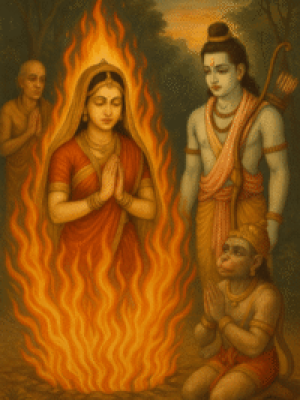“Not Burned, But Believed: The True Tale of Sita"
The Myth of Sita’s Agni Pariksha: Fire, Faith, and Feminine Strength

Among the many poignant moments in the Ramayana, few are as emotionally charged—or as misunderstood—as Sita’s Agni Pariksha. A test of purity by fire, this episode has stirred centuries of debate, reflection, and reimagination. Was it a cruel trial? A divine demonstration? Or something far more symbolic?
Let’s unpack the myth, the context, and its many layers.
The Story: Trial by Fire
After rescuing Sita from the clutches of Ravana, Rama stands before his beloved—but instead of embracing her in triumph, he questions her chastity.
Shocked and heartbroken, Sita declares her purity. But to silence the whispers of doubt in the world and in Rama’s heart, she steps into a blazing fire.
And yet, the fire does not harm her.
Agni, the god of fire, rises to testify: Sita is pure. Untouched. Divine. Only then does Rama accept her back.
The Deeper Symbolism
At first glance, it’s easy to see this as a patriarchal demand for proof of a woman’s worth. But traditional and modern interpretations offer richer perspectives:
- Agni as Witness, Not Punisher
Sita is no ordinary woman—she is often considered an avatar of Lakshmi. By walking through fire unscathed, her divinity is affirmed. It’s not a punishment—it’s a declaration.
Agni is not judging her. He is validating her truth.
- Sita’s Agency
In some tellings, Sita chooses to undergo Agni Pariksha. She takes control of her narrative, refusing to be shamed or pitied. Her fire-walk is her protest and her proof.
It’s as if she’s saying: “I will not argue with you. Let the universe speak for me.”
- The Mirror to Rama’s Dharma
Rama, bound by duty, upholds the expectations of a king—even when it tears him apart. His questioning of Sita is not born out of personal doubt, but public obligation. The Agni Pariksha becomes a dramatic way to balance personal love and societal dharma.
So, what is the real test?
Maybe the real Agni Pariksha was never Sita’s.
Maybe it was ours—a test of how we treat women, how we question love, and how we understand honor.
And maybe Sita, walking through flames with grace, has been telling us all along:
“I am not what you think I am. I am fire.”
